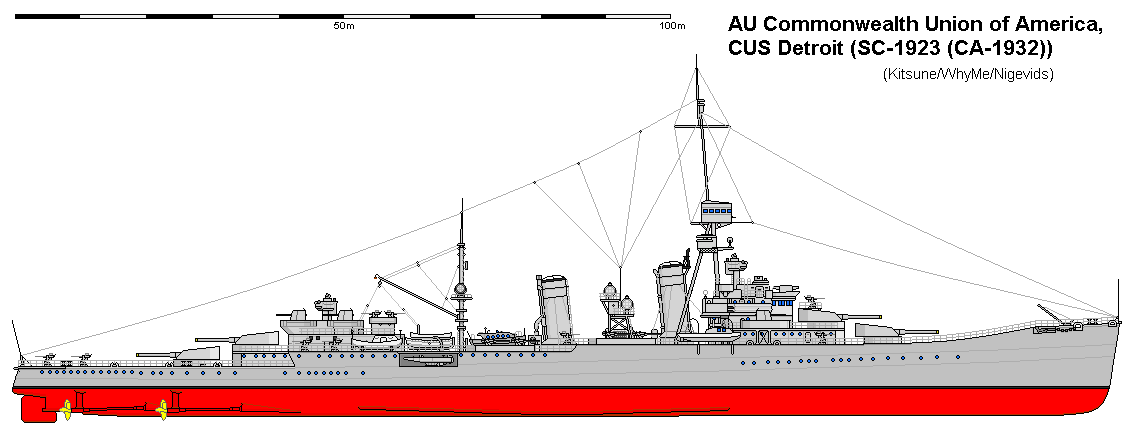
CUS Detroit (SC-1923 (CA-1932))
Back to Commonwealth Union of America ship list:
The last heavy gunned cruiser class built for the CUA navy had been the Albany class of 1910 armed with twelve 10" in lozenge arranged twin turrets. Those four ships were sold 1921-23 or converted to other duties as they were too large and the main guns were also larger than the Geneva Arms Limitation Treaty allowed for cruisers. The Providence class of 1917-18 were supposed to be "scout/flotilla/light" cruisers but ended up being hybrids that the CUA were not comfortable with. The CUA had been angling for a 12,000 ton ship with 8", the British for 8,000 ton and 6", while the Japanese wanted 15,000 tons and no gun limits. The compromise to 10,000 tons and 8" pleased no one but gave rise to what became known as the Heavy Cruisers.
The Detroit class were already in production before these limits were finalised, but that was never going to be a problem as this class was to be a light scout cruiser class and were based on a hull of about 8,000 tons standard.. What actually spurred the completion rate of these ships was the use of the refurbished 8" twin turrets being removed from the Connecticut and Boston class (pre-dreadnoughts, armoured cruisers) that were being reduced to anciliary duties as they became excess to GALT limits. Knowledge that the treaty cruisers would have a 95% chance of being limited to 8" or larger guns, it made sense to utilise the excess twin 8" to speed up production in a class which was sorely needed by the navy.

The design was for a long flowing hull from the very flared bow to the narrow stern. The very high flared bow was to make the ship more weatherly when pushing into moderate to heavy seaways. To act as 'the eyes of the fleet' the ships had to be able to stay ahead of the battlefleet no matter what the weather. With a speed of 32 knots, this gave the ships enough speed to be used in the scout role and with the destroyer flotillas, which although they could be rated at 34-35 knots that sort of speed was only acchieved in a flat calm. The one thing that was not fitted that would have increased their value was the lack of aircraft handling facilities for float/seaplanes. These were the oldest ships to make it to WW2 in their original condition. Radar, and lots of light AA were fitted when available. The ships were reclassified as 'Heavy Cruisers' in 1932 despite having almost no armour. The classification was purely on the gun size.
| Displacement | 7,800 tons std 9,900 tons full load |
| Length | 556 ft |
| Breadth | 56 ft |
| Draught | 22 ft |
| Machinery | 4 shaft steam turbines 70,000shp |
| Speed | 32 knots |
| Range | 8,000 miles at 16 knots (3,000 nm at 28 knots) |
| Armour | 2.5" box over magazines and engine room, 1.5" deck, 6" turrets |
| Armament | 8 x 8" (4x2) 8 x 4" (8x1) 20 x 40mm (5x4) 15 x 20mm (15x1) |
| Aircraft | nil |
| Torpedoes | 6 x 21" (2x3) |
| Complement | 615 |
| Notes | CUS Detroit |
Range of the refurbished 8"/45cal turrets/guns was 25,500 yards at 38 degrees elevation. Rate of fire was 2-3 rounds per minute.